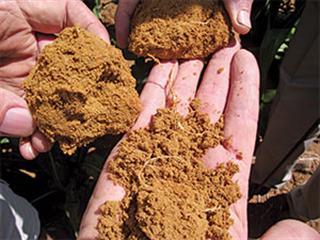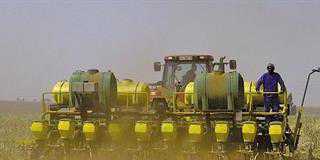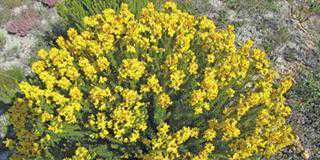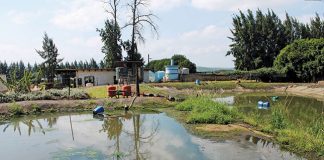
The sandy soils of the north-western maize triangle are highly productive, despite inherent problems of compaction due to the nature of the soil and the pressure of wheeled traffic. During the 1950s and 1960s there were concerns that the north-western Free State and western Transvaal would become a dustbowl. Today, with dust storms virtually eliminated, it is one of the most reliable dryland cropping regions in the country, despite having an average annual rainfall of between 500mm and 600mm.
The most obvious characteristic of this soil is its susceptibility to wind erosion and compaction. Sandy soils are also low in fertility, moisture- retaining capacity and organic material. The effect of compaction is easily overlooked as it is not superficially visible and can only be detected by measuring soil density. This is done by digging a soil profile plot, using a probe or examining plant root distribution in the soil profile.
Most of the sandy soils in the area are aeolian (windblown) and originate from the Kalahari. Wherever this sand, deposited over the millennia, accumulated over impervious clay layers it resulted in what is commonly called water-table sand. The relatively high water infiltration rate through sand and the accumulation of excess water in the soil above the clay layer makes the soil productive even in a low-rainfall environment.
Tlling method
The productivity of these soils for dryland maize received a boost with the concept of rip-on-row, controlled traffic and stubble tillage initiated by Carel Koch in 1972. Rip-on-row is a method of partial no-till now standard practice in this area. In winter, after the harvest, a deep tine ripper loosens the soil to a depth of between 45cm and 80cm. This breaks the compaction layers. Weeds are controlled with a rod weeder or sprayed with a herbicide.
Controlled traffic is a system of limiting cultivation to traffic lanes so that tractors with trailed implements drive on the same tracks at every cultivation. This saves energy, as machines move over smooth surfaces, and keeps compaction inside a limited zone. Stubble tillage is the practice of leaving stubble on the soil surface as a mulch, which stops wind erosion.

Figure 1 represents the profile of a typical sandy soil. The three figures, from left to right, represent no-till, conventional till (mouldboard plough) and rip-on-row cultivation.
Root distribution patterns correspond to the findings of Carel’s investigation in collaboration with the Sandy Soil Development Committee. For sustainable crop production, the cultivation practice should suit the soil- climate (rainfall) interaction. Changes must be based on an understanding of the principles involved in each specific soil-climate situation.
Clay soil in a high rainfall area needs different management to sandy soil in a low rainfall area.
In the 1970s, farmers in the western maize area switched from conventional tilling to rip-on-row and stubble tillage. There were no tillage implements or planters suitable for handling stubble on sand. The Viljoenskroon and Losdoorns study groups worked by trial-and- error to overcome problems and soon other farmers followed their lead.
Heavy machines and compaction
Larger, heavier implements and machines have benefits for the farmer but increase the problem of soil compaction. Carel has been investigating the effect of heavy machines on maize root development under cropping conditions since 2006.
During the 1970s and 1980s, when machinery was smaller and lighter, tractor, harvester and planter wheels ran on the same track in a controlled traffic system. More recently, bigger vehicles, heavier wheels and little control over track positions have increased topsoil compaction. During the harvest, combine wheels running on plant rows can compact moist soil to a depth of 40cm or 50cm.
Soil condition
The object of soil management is to create optimal soil conditions for plant roots. Sandy soil, compacted and degraded by regular, controlled wheel traffic, needs periodic deep tilling to stimulate root development. Deviation from the position of the previous crop’s plant row will restrict root growth and reduce yield. Root development will show the positions of wheel tracks in the land.
The plant uses energy trying to penetrate compacted soil layers. The subsoil moisture reserve in a sand soil is often more than 1m deep. Restricted root growth will prevent root access to the moisture reserve and this can substantially reduce yields. Carel is currently testing a system of permanent traffic control designed to reduce tillage, maintain optimal soil condition and enable a high yield.
Carel Koch
arel’s first practical experience of restricted maize root development dates back to 1967 on the farm Hakbospan in the Wesselsbron district. The farm belonged to Ben Otto and is now farmed by his grandson Ben Otto (Jnr), brother of Farmer’s Weekly writer Annelie Coleman. Annelie and Carel discovered their connection 45 years later.
Carel points out that, although, SA’s implement market is relatively small, his approach creates opportunites for local manufacturers to supply the demands for implements required by the variations in our soils and the size of our farms.

Compacted zones often occur deep in the soil profile, as the horizontal layer between the lines on the right shows. The ripper tine on the left went deep (75cm) to enable roots to reach moisture. The tine on the right (40cm), above the compact zone, was too shallow to encourage deep root development. Photo by Carel Koch
Carel Koch graduated with a BSc Agriculture from Stellenbosch University in 1953. He worked as an extension officer in the western Free State before moving into the private sector. Contact Carel Koch on 082 442 2589 or email [email protected].













